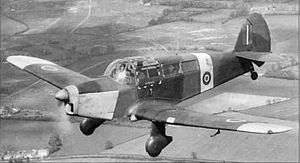de Havilland Gipsy Queen
| Gipsy Queen | |
|---|---|
| | |
| A de Havilland Gipsy Queen 70-4 at the Royal Air Force Museum Cosford | |
| Type | Piston inline aero engine |
| Manufacturer | de Havilland Engine Company |
| First run | 1936 |
| Major applications | de Havilland Dragon Rapide |
| Number built | c.5,000 |
| Developed from | de Havilland Gipsy Six |
The de Havilland Gipsy Queen is a British six-cylinder aero engine of 9.2 litres (560 cu in) capacity that was developed in 1936 by the de Havilland Engine Company. It was developed from the de Havilland Gipsy Six for military aircraft use.[1] Produced between 1936 and 1950 Gipsy Queen engines still power vintage de Havilland aircraft types today.
Variants
Note:[2]
- Gipsy Queen I
- (1936) 205 hp (153 kW), military version of Gipsy Six II. Splined crankshaft, but intended for fix-pitch airscrews fitted with an adapter. No fittings for a VP airscrew fitted. Very limited production.
- Gipsy Queen II
- (1936) 210 hp (160 kW), military version of the Gipsy Six Series II. Strengthened crankcase. Splined crankshaft for V/P airscrew.
- Gipsy Queen III
- (1940) 200 hp (150 kW), military version of Gipsy Six, strengthened crankcase, tapered crankshaft for fixed-pitch;-1,358 built. Most of these engines were fitted with a very basic top-cover, as per the early Gipsy-Six, with no accessory drives at the rear of the top-cover whatsoever.
- Gipsy Queen IV
- (1941) Supercharged version, originally designated Gipsy Queen IIIS, designated Gipsy Queen 50 in June 1944. Only a handful were made. This engine was widely advertised at the time, however, it never entered production, as it was superseded by the completely re-engineered Queen 30.
de Havilland Gipsy Queen 30 on display at the Fleet Air Arm Museum
- Gipsy Queen 30; All-new engine from this point. (120 mm x 150 mm = 10.18 L)[3]
- (1946) 240 hp (180 kW), 1,762 built.
- Gipsy Queen 30-2
- (1946) 240 hp (180 kW).
- Gipsy Queen 30-3
- (1946) 240 hp (180 kW).
- Gipsy Queen 30-4
- (1946) 240 hp (180 kW).
- Gipsy Queen 32
- (1946) 250 hp (190 kW).
- Gipsy Queen 33
- As Gipsy Queen 30 for pusher installation.
- Gipsy Queen 34
- As Gipsy Queen 30.
- Gipsy Queen 50
- (1944) 295 hp (220 kW), Single-speed, single stage supercharger. 14 built.
- Gipsy Queen 51
- 295 hp (220 kW), as Gipsy Queen 50.
- Gipsy Queen 70-1
- (1946) Renamed Gipsy Six S.G, 1,889 built. Supercharged with reduction-drive.
- Gipsy Queen 70-2
- 380 hp (280 kW)3. Supercharged with reduction-drive.
- Gipsy Queen 70-3
- 380 hp (280 kW). Supercharged with reduction-drive.
- Gipsy Queen 70-4
- 340 hp (250 kW). Supercharged with reduction-drive.
- Gipsy Queen 71
- (1950) 330 hp (250 kW). Supercharged with reduction-drive.
Applications
- Airspeed Oxford
- Breda Ba.44
- Cierva W.9
- Fiat G.46 bis and G.46-2
- de Havilland Dragon Rapide
- de Havilland Dove
- de Havilland Heron
- Handley Page Marathon
- Heston A.2/45
- Miles Mentor
- Miles Merchantman
- Parnall Heck
- Parnall 382
- Percival Merganser
- Percival Prentice
- Percival Proctor
- Planet Satellite
- Scottish Aviation Pioneer
- Short Sealand
- Youngman-Baynes High Lift
Survivors
Of the 11 Gipsy Queen-powered de Havilland Doves on the British register, only two remain airworthy as of April 2011.[4]
Engines on display
Preserved de Havilland Gipsy Queen engines are on public display at the following museums:
- Australian National Aviation Museum - Queen 30
- de Havilland Aircraft Heritage Centre
- Evergreen Aviation & Space Museum, McMinnville, Oregon - Queen 70 Mk.2
- Fleet Air Arm Museum, RNAS Yeovilton.
- Museo Nacional de Aeronáutica de Argentina - Queen 70-3
- Royal Air Force Museum Cosford
- Imperial War Museum Duxford
- Montrose Air Station Heritage Centre
Specifications (Gipsy Queen I)
Data from Lumsden [5]
General characteristics
- Type: 6-cylinder inverted inline piston engine
- Bore: 4.646 in (118 mm)
- Stroke: 5.512 in (140 mm)
- Displacement: 560.6 cu in (9.186 L)
- Length: 63.5 in (1,587 mm)
- Width: 20.5 in (513 mm)
- Height: 33.5 in (838 mm)
- Dry weight: 486 lbs (220 kg)
Components
- Valvetrain: Overhead valve
- Fuel type: 87 octane petrol
- Oil system: Dry sump
- Cooling system: Air-cooled
Performance
- Power output: 208 hp (155 kW) at 2,400 rpm
- Compression ratio: 6.5:1
- Power-to-weight ratio: 0.43 hp/lb (0.7 kW/kg)
See also
- Related development
- Comparable engines
- Related lists
References
Notes
Bibliography
- Jane's Fighting Aircraft of World War II. London. Studio Editions Ltd, 1989. ISBN 0-517-67964-7
- Lumsden, Alec. British Piston Engines and their Aircraft. Marlborough, Wiltshire: Airlife Publishing, 2003. ISBN 1-85310-294-6.
- Gunston, Bill. Development of Piston Aero Engines. Patrick Stephens Limited, 1999. ISBN 978-1-85260-619-0.
External links
| Wikimedia Commons has media related to De Havilland Gipsy Queen. |
This article is issued from Wikipedia - version of the 8/1/2015. The text is available under the Creative Commons Attribution/Share Alike but additional terms may apply for the media files.

